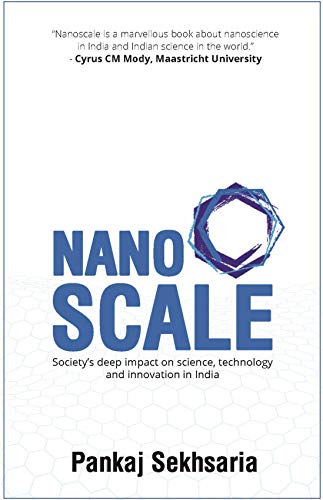Nanoscale: The biggest “small secrets”
Book Review
Srujana Mohanty

How do labs in our country perform cutting edge research despite financial constraints? Do science and ayurveda go hand in hand? Does scientific innovation crumble under market pressure? Dr. Pankaj Seksharia's ‘Nanoscale’ answers these burning questions and gives us a thorough insight into four of India's leading laboratories.
Tweet
From state-of-the-art and massive equipment to swarn bhasma (gold dust) and its anti-arthritic properties; ‘Nanoscale’ is a comprehensive, yet concise endeavour of bringing nanoscience and nanotechnology research into centre stage, through a narrative encompassing the social and scientific community surrounding it.
Nanoscale is a story weaved out of four first-hand accounts, from within nanoscience and technology laboratories in our country. Dr Pankaj Sekhsaria, Associate Professor at the Centre for Technology Alternatives for Rural Areas (C-TARA), IIT Bombay, a man of science and an author to books on diverse topics - ranging from the cultural and biological assortments in the Jarawa tribe of the Andaman to stories within research labs of the country, brings his unique analytical approach to ‘Nanoscale’ as well. He lays before us four different perspectives, revolving around nanoscience, and it's a niche in our society.
‘Nanoscience’ and ‘Nanotechnology’ are umbrella terms used for the study of matter at a minuscule and fundamental level. It arises from the prefix “nano” added to metre - a scale of measure which we are all aware. A nanometre is essentially one billionth of a metre. For example, gold looks shiny and golden to our naked eyes, but nanoparticles of gold appear very different - blue and red in colour, cannot be seen with naked eyes, and do not always reflect the holistic properties of gold.
The book begins with a discussion of the pitfalls of scientific infrastructure in India, why that may be pulling the scientific community down, and how it can be brought at par with the leading giants of the world. He says that the challenge in India is not only limited to financial resources but the deficits in the capacity of resource establishment in colleges, universities, and other higher education institutions of the government.
A rather interesting chapter of the book revolves around the idea of ‘jugaad’. Dr Sekhsaria explores the murky waters of this concept and provides us with a balanced account of improvisation versus scientific innovation. He defines ‘jugaad’ as “A creative improvisation, a tool to somehow find a solution, ingenuity, a refusal to accept defeat initiative, quick thinking, cunning resolve and all the above.” He goes on to discuss how deep-rooted it is in a country like ours. “Jugaad to Indians was both instinct and inspiration”, he says. He summons the scientific community to draw inspiration from this ingenious concept, to seek opportunity in adversity, but not form a dependence on improvisation.
The book further brings into focus how publication records often undermine innovation, ingenuity, and brilliance of scientific designs and studies. This also regulates the plan of action regarding the commercialisation of technology and products. The science done in laboratories needs to make its way through the lab doors and be available in such a way that the masses can benefit from it.
Dr Sekhsaria emphasises that even if the innovation is ground-breaking and can benefit millions, if not marketed with the right strategy, it would not reach those who need it and thus its entire purpose is futile. He touches upon two pertinent societal issues where nanoscience is building a silver lining for the people of this country - availability of clean drinking water and the treatment of Retinoblastoma, an eye cancer that primarily affects young children.
Nanoscale also reflects upon the controversial amalgamation of ancient ayurvedic practices and the relatively modern scientific discipline of nanoscience. The author attempts to give us an objective and uncritical analysis of the two and seems hopeful that the two streams can join hands someday to unravel greater mysteries together. He suggests that it might be a possibility if both can simultaneously exist in harmony and treat each other with mutual respect.
Dr Seksharia comes full circle towards the end of the book. He ends where he started, with the discussion of societal and cultural influences on science and technology. The people for whom technology is created need to be appreciative of its value; else all development is unfruitful. The book is a testimony to the challenges that scientists and researchers take upon themselves, to ensure people benefit from their innovation.
The book has the potential to attract a non-technical readership, with it’s simplified approach to advanced scientific research and an autobiographical narrative. However, there are portions which may not resonate with the community outside academia, and it becomes a slightly monotonous read. The narrative is highly descriptive in nature, which beautifully captures the essence of scientific research and lives of researchers, but may be perceived as mildly deviant at times.
Although the primary focus of Nanoscale is nanoscience labs, it paints a broader picture of science and technology research in India and the interdependence of science and society. The exhaustive documentation efforts that have led to this book are evident; not only through the multiple photographs incorporated within the text, but also through the in-depth information provided. Nanoscale is a succinct repertoire of insights into nanoscience and nanotechnology research in our country and a portrayal of the lives involved.
End Note:
Cogito137 received a request to review ‘Nanoscale’ from Dr. Pankaj Sekhsaria, the author of the book. This review was done by Srujana Mohanty, one of our editors.
This book can be purchased online. The author may be contacted for offline copies.
Srujana Mohanty is a third-year undergraduate student pursuing Integrated BS-MS in Chemistry, at IISER Kolkata. She writes blogs and watches TV series in her free time.
signup with your email to get the latest articles instantly